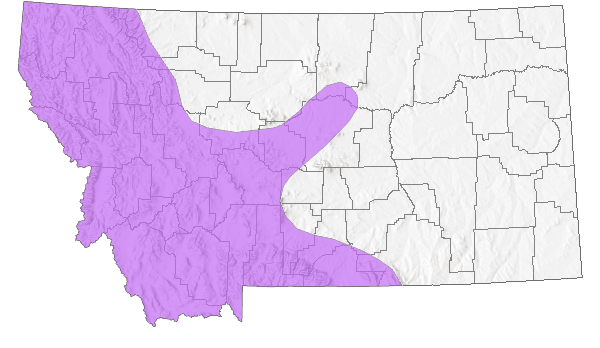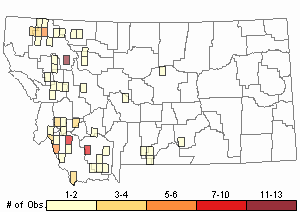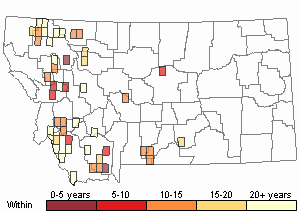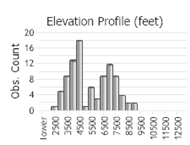View in other NatureServe Network Field Guides
NatureServe
Montana
Utah
Wyoming
Idaho
Wisconsin
British Columbia
South Carolina
Yukon
California
New York
Few-flower Spikerush - Eleocharis quinqueflora
Other Names:
Eleocharis pauciflora, Eleocharis suksdorfiana
Native Species
Global Rank:
G5
State Rank:
SNR
C-value:
7
Agency Status
USFWS:
USFS:
BLM:
External Links
General Description
PLANTS: Short-rhizomatous, perennial herbs that can be mat-forming and grow up to 30 cm tall. The bases of tufted stems often have bulbs. Source: Lesica et al. 2012.
LEAVES: Leaves are bladeless and reduced to 2 sheaths on the lower stem. The sheath of the distal leaf is firm and persistent. The leaf tip is truncate to acute without a tooth-like projection. Source: Lesica et al. 2012.
INFLORESCENCE: A 4-8 mm long single spikelet usually with 5 flowers. Florets are tightly packed and spirally arranged. Source: Lesica et al. 2012.
The specific epithet quinqueflora is a combination of the two Latin words quinque, meaning five, and flora, meaning flower, referring to the typically 5-flowered inflorescence. Eleocharis is made up of the two Greek words hele- and -charis meaning “marsh” and “grace” respectively (Merriam-Webster).
Phenology
This species flowers June through August and fruits during late summer. Source: Flora of North America 2019.
Diagnostic Characteristics
Montana has eight
Eleocharis species. They are generally mat-forming wetland herbs with inflorescences consisting of a single, solitary spikelet (Lesica et al. 2012).
Few-flower Spikerush -
Eleocharis quinqueflora, native
*Habit: An erect, short-rhizomatous perennial.
*Stems: 5-25 cm tall and tufted.
*Spikelets: 4-8 mm long and usually with 5 flowers.
*Achenes: Brown, smooth, narrowly obovate, and 2-3 mm long. The upper portion of the achene forms a distinct beak that is confluent with the lower portion that is 3-sided.
*Stigmas: 3
Beaked Spikerush -
Eleocharis rostellata, native, SOC
*Habit: A low-growing, tufted (cespitose) perennial. Stems are erect or arching and rooting at the tips.
*Stems: More or less flat, some arching to the ground and rooting at the tips. Plants are 10-80 cm tall.
*Spikelets: 4-10 mm long with few to many flowers.
*Achenes: Grayish-green, about 2 mm long. The upper portion of the achene is conical and confluent with the lower portion that is 3-sided to nearly round in cross section.
*Stigmas: 3
Creeping Spikerush -
Eleocharis palustris, native
*Habit: An erect, rhizomatous perennial.
*Stems: More or less cylindrical stems that are 7-90 cm tall with purple bases.
*Spikelets: 5-25 mm long with numerous flowers.
*Achenes: A yellow to brown, smooth, obovate achene that is 2-3 mm long. The upper portion of the achene is pyramidal in shape and appearing separated from the lower portion which is orbicular to lenticular in shape.
*Stigmas: 2
Species Range
Montana Range
Range Descriptions

 Native
Native
Range Comments
Few-flower Spikerush is circumboreal and in North America occurs south to California, Arizona, New Mexico, Nebraska, Illinois and New York (Lesica et al. 2012).
Observations in Montana Natural Heritage Program Database
Number of Observations: 105
(Click on the following maps and charts to see full sized version)
Map Help and Descriptions
Relative Density

Recency



 (Observations spanning multiple months or years are excluded from time charts)
(Observations spanning multiple months or years are excluded from time charts)
Habitat
Few-flower Spikerush prefers moist to wet, often peaty, often calcareous soil of fens, wet meadows, and seeps in the montane and rarely as high as the alpine zone in Montana (Lesica et al. 2012).
National Vegetation Classification System Groups Associated with this Species
Wetland and Riparian
Peatland
Wet Meadow and Marsh
Ecology
ASSOCIATED SPECIES
Few-flower Spikerush is commonly associated with graminoids such as Water Sedge (Carex aquatalis) and other Carex species as well as Tufted Hair Grass (Deschampsia cespitose), Beaked Spikerush (Eleocharis rostellata), Tufted Bulrush (Trichophorum cespitosum), and Marsh Arrowgrass (Triglochin palustris) (NatureServe 2019). Associated forbs include White Marsh Marigold (Caltha leptosepala), Alpine Shootingstar (Dodecatheon alpinum), Primrose Monkeyflower (Mimulus primuloides), Tundra Aster (Oreostemma alpigenum), Elephanthead Lousewort (Pedicularis groenlandica), and American Bistort (Polygonum bistortoides) (NatureServe 2019).
A study of wetlands in Slovenia revealed Lesser Bladderwort (Utricularia minor) to be a common associate of Few-flower Spikerush in permanent wet depressions (Zelnik et al. 2010).
PARASITES
Entorrhiza scirpicola is a fungus that can be found embedded in the root cells of Few-flower Spikerush populations in Britain (Hooper et al. 1981). Fungi in this genus are characterized by the formation of galls on the roots of their host plants, members of Cyperaceae and Juncaceae (Hooper et al. 1981). The fungus does not seem to have any negative effects on its host plants (Fineran 1970).
GRAZING
A study investigating the effects of herbage removal on the productivity of different meadow types revealed moderately mesic habitats dominated by Few-flower Spikerush to be among the more sensitive communities (Stohlgren et al 1989). Any amount of herbage removed before late-season plant senescence resulted in a significant decrease in productivity. This implies that stock animal grazing in these areas should be planned and monitored very carefully.
Reproductive Characteristics
FLOWERS [Lesica et al. 2012]
Flowers consist of no or 3 to 6 perianth bristles, 3 stigmas, and 3 stamens. The bristles may be longer or shorter than the achene. The scales are 3-6 mm long and brown to purple, the lowest scale larger than the rest.
ACHENES [Lesica et al. 2012]
Achenes are brown, smooth, narrowly obovate, and 2-3 mm long. The upper portion of the achene forms a distinct beak that is confluent with the lower portion that is 3-sided.
LIFE CYCLE
Few-flower Spikerush is a perennial species (Lesica et al. 2012).
Management
Grazing animal stock after plant senescence in moderately mesic plant communities dominated by Few-flower Spikerush should maintain higher productivity (Stohlgren et al. 1989).
Stewardship Responsibility
Threats or Limiting Factors
Intensive herbage removal by grazing may have long-term negative effects on Few-flower Spikerush dominated meadows (Stohlgren et al. 1989). These effects would likely coincide with soil compaction over the long-term.
References
- Literature Cited AboveLegend:
 View Online Publication
View Online Publication Lesica, P., M.T. Lavin, and P.F. Stickney. 2012. Manual of Montana Vascular Plants. Fort Worth, TX: BRIT Press. viii + 771 p.
Lesica, P., M.T. Lavin, and P.F. Stickney. 2012. Manual of Montana Vascular Plants. Fort Worth, TX: BRIT Press. viii + 771 p.
- Additional ReferencesLegend:
 View Online Publication
View Online Publication
Do you know of a citation we're missing? Lesica, P., M.T. Lavin, and P.F. Stickney. 2022. Manual of Montana Vascular Plants, Second Edition. Fort Worth, TX: BRIT Press. viii + 779 p.
Lesica, P., M.T. Lavin, and P.F. Stickney. 2022. Manual of Montana Vascular Plants, Second Edition. Fort Worth, TX: BRIT Press. viii + 779 p. Williams, K.L. 2012. Classification of the grasslands, shrublands, woodlands, forests and alpine vegetation associations of the Custer National Forest portion of the Beartooth Mountains in southcentral Montana. M.Sc. Thesis. Bozeman, MT: Montana State University. 376 p.
Williams, K.L. 2012. Classification of the grasslands, shrublands, woodlands, forests and alpine vegetation associations of the Custer National Forest portion of the Beartooth Mountains in southcentral Montana. M.Sc. Thesis. Bozeman, MT: Montana State University. 376 p.
- Web Search Engines for Articles on "Few-flower Spikerush"





